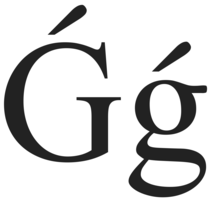Ǵ
Ǵ, ǵ (G with acute accent) represents the Pashto letter geh (ږ), the Macedonian letter gje Ѓ and, in Karakalpak, /ʁ/ (Cyrillic Ғ) and parts of Cantonese Yale Nǵ and Nǵh. The letter is also used to transcribe the Old Church Slavic letter djerv Ꙉ.[1]
| Ǵ | ǵ |

Doulos SIL glyphs for Majuscule and minuscule ǵ.
The 2019 reformed alphabet[2] for Uzbek also contains this letter. It is currently represented by Gʻ.
In Kazakh, it was suggested to use this alphabet to replace the Cyrillic Ғ, but in 2019 the replacement suggestion is replaced by Ğ.
Computing code
| Preview | Ǵ | ǵ | ||
|---|---|---|---|---|
| Unicode name | LATIN CAPITAL LETTER G WITH ACUTE | LATIN SMALL LETTER G WITH ACUTE | ||
| Encodings | decimal | hex | decimal | hex |
| Unicode | 500 | U+01F4 | 501 | U+01F5 |
| UTF-8 | 199 180 | C7 B4 | 199 181 | C7 B5 |
| Numeric character reference | Ǵ | Ǵ | ǵ | ǵ |
| Named character reference | ǵ | |||
gollark: But, well, it's kind of better in some ways since it means that a CA on the actual web can't just read some traffic sent between a server and browser.I must note that your thing doesn't really (seem to) protect client->server data.
gollark: Admittedly the actual web has that (CAs and the DNS servers).
gollark: I can't see any reason that wouldn't work, but it *does* seem to introduce a lot of dependence on the registrar.
gollark: How do the registrar and server securely communicate this "one time string/message"?
gollark: So they share a key from data sent over a connection which does *not* require them to both have a key.
References
- Lunt, Horace (1974). Old Church Slavonic Grammar. The Hague: Mouton. p. 16.
- https://eurasianet.org/uzbekistan-unveils-its-latest-bash-at-latin-alphabet
This article is issued from Wikipedia. The text is licensed under Creative Commons - Attribution - Sharealike. Additional terms may apply for the media files.